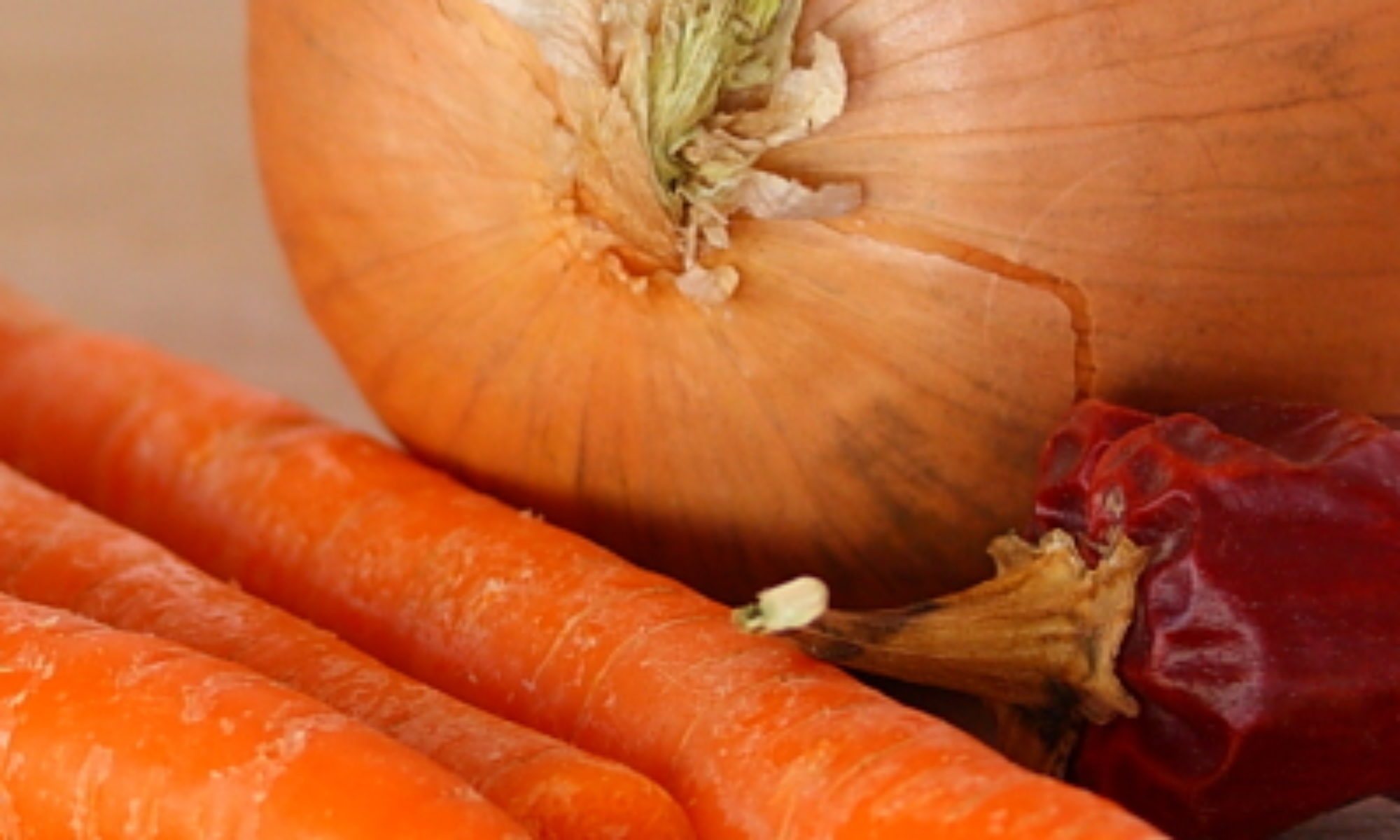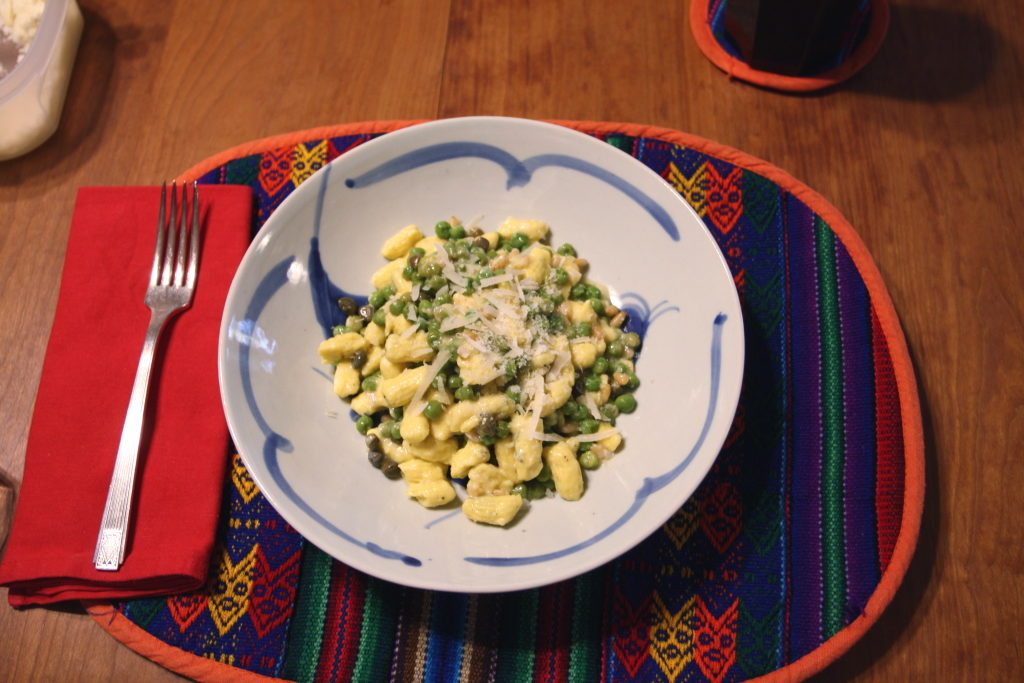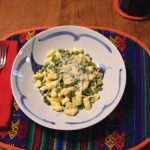
We get a nice, mild, fresh goat cheese (chèvre) every other week from Black Mesa Ranch. It’s shipped directly from the ranch and we pick it up along with our CSA produce, making it easy to source some of our dairy products locally. The downside is that we often don’t know in advance what we’ll be making with the goat cheese. In that case, the cheese log goes into the freezer until we can figure out something. As we did with today’s post.
This came almost entirely from the idea of using up some of our goat cheese. First, we hit on the idea of making Parisian gnocchi (the dough is basically a savory cream puff dough), adding the cheese and some herbs and cooking it in some light sauce. We went light, since it’s pretty warm out these days, and light meals are perfect matchs for the heat. The sauce, we pretty much made up based on staples that we had on hand: capers, peas, pine nuts, and Parmesan cheese. Altogether, this is another Scratchin’ original, so you won’t find it anywhere else.
Chèvre and Sage Gnocchi with Peas, Capers, and Pine Nuts
Ingredients
For the gnocchi
- 1 cup sifted all-purpose flour (125 g)
- 1/4 tsp salt
- 3 ounces fresh goat cheese (90 g)
- 2 tsp minced fresh sage
- 1/4 tsp freshly ground black pepper
- 1 cup water
- 6 Tbs unsalted butter (65 g)
- 4 eggs
For the sauce
- 2 Tbs butter
- 2 cloves garlic minced
- 2 Tbs pine nuts
- 1/2 batch of gnocchi above
- 1 cup frozen peas
- 2 Tbs capers drained
- 1/2 cup dry white wine such as Pinot Grigio
- 1/2 cup grated Parmesan cheese
- Kosher salt
- Freshly ground black pepper
Instructions
For the gnocchi
- Have everything ready before starting. In a small bowl or measuring cup, combine flour and salt. Place cheese, sage, and pepper in another bowl. No need to mix.
- Bring water and butter to a boil in a heavy-bottomed saucepan over medium-high heat.
- Add flour and salt mixture all at once and stir rapidly with a wooden spoon until it comes together in a ball and cleans the side of the pan. Continue stirring and cooking to release steam, until a film forms on the bottom of the pan, about 3 minutes. Remove from heat and stir to cool for a minute or two.
- Add eggs, one at a time, beating each in completely before adding the next.
- Add cheese, sage, and pepper, and stir until blended.
- Scoop into a pastry bag and let rest 30 minutes.
For the sauce
- Melt butter in a large skillet over medium heat. Add garlic and pine nuts and cook until garlic is softened, about 3 minutes. Reduce heat to very low to keep warm while you prepare the gnocchi.
- Bring a large kettle of salted water to a boil. Reduce to a simmer and pipe dough into the simmering water, using kitchen shears to cut off 3/4-inch lengths. Cook the gnocchi in batches of about 50. Let gnocchi simmer for about 2 minutes, removing with a slotted spoon and placing in the skillet with garlic and pine nuts.
- The remaining dough can be piped onto a baking sheet and frozen for baking as gougères.
- Increase the heat under the skillet to medium and cook until gnocchi are heated through. Add peas, capers, and wine, and bring to a simmer.
- Stir in Parmesan cheese, season to taste with salt and pepper.
Ingredient discussion:
For the gnocchi: watch those eggs, as they’re key. Get them from a source you trust; you’ll have better eggs. For the cheese, some goat cheeses are too goat-y for us and we don’t like that. We’re fortunate that the cheese sent down from Black Mesa Ranch is just perfect. A slight tang, but none of that goat-y barnyard taste. The sage, well, we used that because we have some growing in the yard; we might have chosen something else and the gnocchi would have been just as good. For the sauce: again, partly we selected the ingredients based on what we had on hand, so swap out as needed. Use walnuts instead of pine nuts, use pieces of zucchini in place of peas, use vegetable broth in place of the wine. But do use a good aged cheese like Parmesan (Grana Padano, Romano, Pecorino) which you have to grate yourself. Why? Cheese loses flavor once it’s grated, and the flavor is what you’re after, so why buy the stuff with less flavor?
Procedure in detail:
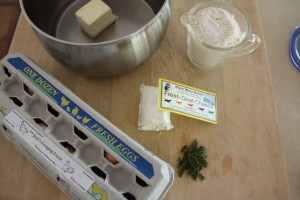
Mise en Place. We like to use the term mise en place. It makes us feel all chefy, but, more than that, it makes preparing dishes in the kitchen a breeze. It’s one of the secrets of professionals; they’ll often spend all afternoon getting everything prepped for the evening service, and it really works. For making this dough, it’s essential, so make sure to do the following steps before starting.
Combine flour and salt. No need to mix; you’ll be doing enough mixing in a few minutes, so, for now, just measure out the flour and put the salt on top. Perfect. As an aside, we say sifted flour, but the only reason to sift is for measuring. With a scale, we just measure 125 grams (the weight of a sifted cup of all-purpose) instead of 140 grams (the weight of non-sifted flour). You can also just do a scant cup of flour — remove a tablespoon or so from a full cup.
Combine cheese and spices. Again, no need to mix; just have it ready to add to the gnocchi when the time comes, so place the cheese in a small bowl, and add the sage and black pepper. We’re good to go.
Boil water and butter. Combine butter and water in a heavy bottomed saucepan and bring to a boil over medium heat. Now’s the time to catch your breath, because everything’s going to happen all at once when the water starts boiling.
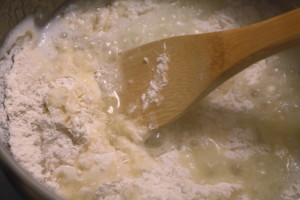
Add flour and salt. Once boiling, dump in all the flour and salt in one fell swoop, and start stirring like mad with a wooden spoon. Keep stirring. At first the dough will be kind of lumpy and look bad, but it’ll smooth out in a minute. Keep stirring, and keep that pan over medium. As you’re stirring, a layer of dough will stick to the pan, which is what you want; keep stirring until that happens, about 2 to 3 minutes. Remove from heat.
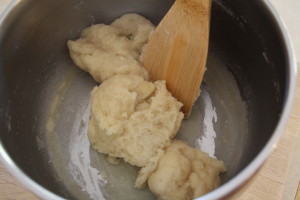
Keep stirring. Yes, your arm is tired, but tough it out, and keep stirring for a minute or two longer to dissipate some of the heat. We’ll be adding eggs and we don’t want to cook them. Are your two minutes up? Great.
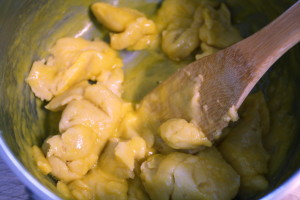
Add egg. We chose the singular noun deliberately. Add one egg and beat it in. Yes, it’s tough and your arm’s burning, but being a chef sometimes requires some serious muscle and endurance. Once the egg is beaten in completely, add another and beat in that one. Keep adding and beating until all the eggs are incorporated.
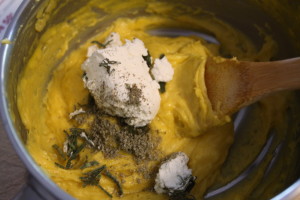
Add cheese. You’re almost home-free, so add the cheese and herbs and stir them in until the batter is smooth. Whew. Rest that arm.
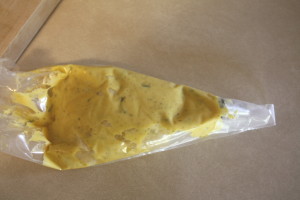
Place in piping bag. You don’t have to pipe this dough, but it does make for more uniform gnocchi. If you don’t have a piping bag, you can use a freezer bag with a corner cut off, but, whatever you use, get the dough into a bag and let it rest for 30 minutes.
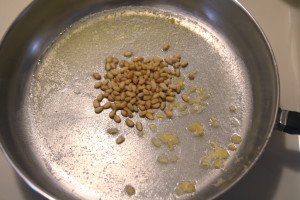
Start sauce. You, however, don’t get to rest. You need to start on the sauce, so melt the butter in a skillet over medium heat and add the garlic and pine nuts. Once the garlic is tender, you can turn the heat to very low to keep it warm.
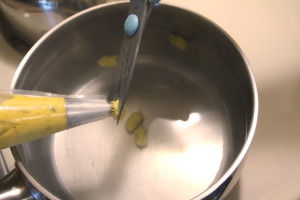
Boil gnocchi. Bring a large kettle of salted water to a boil, then reduce to a simmer. Hold the piping bag over the boiling water and squeeze out some dough. Use kitchen shears to cut off pieces about 3/4-inch long. Keep doing this until you have about 50 gnocchi in the simmering water. Allow them to simmer and cook for about 2 minutes, then remove with a slotted spoon and place in the skillet along with the garlic and pine nuts. Give them a little stir to coat with butter. Repeat cutting and boiling gnocchi until you have enough for two servings. For us, that was about 150 gnocchi.
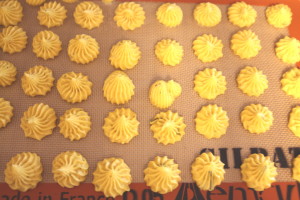
Make gougères. This is optional, but, if you have dough left, simply pipe it into small mounds on a baking sheet lined with a silicone baking mat and freeze. Once frozen, place in a freezer bag. At a later date, you can bake up some gougères by following these instructions.
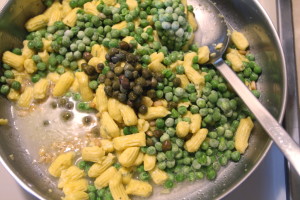
Add peas and capers. Increase the heat under the skillet to medium and cook until the gnocchi are slightly browned. Add the peas, capers, and wine, and bring to a simmer.
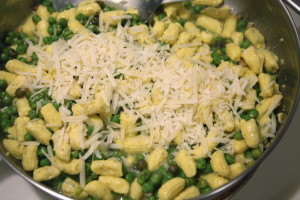
Add Parmesan and season. Stir in the Parmesan cheese, taste and add salt and pepper as needed. Serve in warmed bowls with a small amount of Parmesan as a garnish.
The sauce had a really nice balance of flavors. Not too much cheese, not too much vinegar from the capers, and not too green-tasting from the peas, nor too piney from those pine nuts. Instead, it was just about perfect — it might have benefited from the tiniest amount of red pepper flake, or just a bit of grated nutmeg — so we were quite happy with our dinner. Making Parisian gnocchi isn’t for everyone; they do take some effort, but they always turn out light and tender, unlike potato gnocchi which we’ve had dense and rubbery (ugh). Because of the stirring required, four stars.
